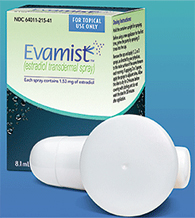Product
Evamist
Approval Date
August 9, 2007
Release Date
April 25, 2008
Company
Ther-Rx
Class
Estrogen
Indication
Moderate to severe vasomotor symptoms of menopause.
Active Ingredient
Estradiol 1.53mg/spray; transdermal spray.
Agency Roster
AbelsonTaylor
Marketing Strategy/Execution
“You just may find relief in a mist,” tout marketers of this hot-flash spray, evoking a tagline they hope will differentiate Evamist among the array of patches, lotion, gels and pills available for the symptoms of menopause. Approved in August 2007 and launched in April 2008, Evamist is the first estradiol transdermal spray for this indication. Specialty pharma company KV Pharmaceutical is marketing the drug through its branded subsidiary, Ther-Rx, whose sales force has an established relationship with OB/GYNs. Fast-drying sprays offer such potential benefits as low or no skin irritation and simple dosing, without patch residue. Evamist has been shown to reduce both the severity and frequency of hot flashes—all in a low dose of estrogen that’s delivered directly to the bloodstream via the skin.
Physician Outlook
Evamist (metered dose transdermal estradiol spray) for the treatment of moderate to severe vasomotor symptoms due to menopause was recently approved by the FDA. Similar to other transdermal estrogens (gels, creams, patches) it provides an option for women who elect to use estrogen therapy to treat menopausal symptoms but prefer a lower dose, non-oral administration. Its daily dosing could be a disadvantage versus weekly patches but may be preferred by women whose skin is irritated by the patch. Compared to topical gels and creams that require 2-3 minutes to dry post application, Evamist may have a slight advantage with its claimed 67-second drying time.
— Sue Ramspacher, Sr. VP, GfK Market Measures
Also in the Pipeline (courtesy of Adis R&D Insight)
No competitor compounds in phase III or pre-registration, US
Recent MM&M Coverage
Product News
Company News
Pharmacology
The addition of exogenous estrogens helps to alleviate the vasomotor symptoms associated with declining estrogen levels.
Evamist is designed to deliver estradiol to the blood circulation following topical application to the skin of a rapidly drying solution from a metered-dose pump. One spray of Evamist contains 1.53mg estradiol.
Clinical Trials
In a 12-week, randomized, double-blind, placebo-controlled clinical trial, a total of 454 postmenopausal women were randomized and received at least one dose of Evamist or placebo. Efficacy was determined as a statistically significant and clinically significant (at least two per day or 14 per week difference) reduction in hot flush frequency and a statistically significant reduction in severity for Evamist versus placebo. One, two, or three daily sprays of Evamist were shown to be better than placebo for relief of frequency and severity of moderate to severe vasomotor symptoms at Week 4 and Week 12.
Adverse Reactions
Headache, breast/nipple pain, nausea, back pain, nasopharyngitis.
Adults
Prime pump before 1st use. Apply to clean, dry, unbroken skin on the inside of the forearm between the elbow and wrist. Initially 1 spray daily; may increase to 2–3 sprays if needed; do not spray in the same area. Reevaluate periodically. Allow spray to dry before dressing; do not wash area for at least 30 minutes after application.
Children
Not applicable.
Contraindications
Breast or estrogen-dependent carcinoma. Undiagnosed abnormal vaginal bleeding. Thromboembolic disorders (eg, stroke or MI within one year, DVT, pulmonary embolism). Thrombophlebitis. Liver dysfunction or disease. Pregnancy (Cat.X).
Precautions
Use shortest duration and lowest dose consistent with treatment goals and risks. Not for prevention of cardiovascular disease (CVD) or dementia. Increased risk of endometrial carcinoma or hyperplasia in women with intact uterus (adding progestin is essential). Renal dysfunction. Gallbladder disease. Hypertriglyceridemia. Hypothyroidism. Hypercoagulability. Conditions aggravated by fluid retention. Bone disease associated with hypercalcemia. Do initial complete physical; repeat annually (include BP, mammogram, PAP smear). Discontinue if visual disturbances or jaundice occurs, and during immobilization, and at least 4–6 weeks before surgery associated with thromboembolism. Manage risk factors for CVD and VTE appropriately. May aggravate asthma, diabetes, epilepsy, migraine, porphyria, SLE, hepatic hemangiomas. May interfere with lab tests (eg, thyroid, PT, glucose tolerance, HDL-C/LDL-C). Product is flammable. Nursing mothers.
Interactions
Avoid applying sunscreen 1 hr after (decreases estradiol absorption). May need higher doses of thyroid-replacement therapy. May be antagonized by CYP3A4 inducers. May be potentiated by CYP3A4 inhibitors.









